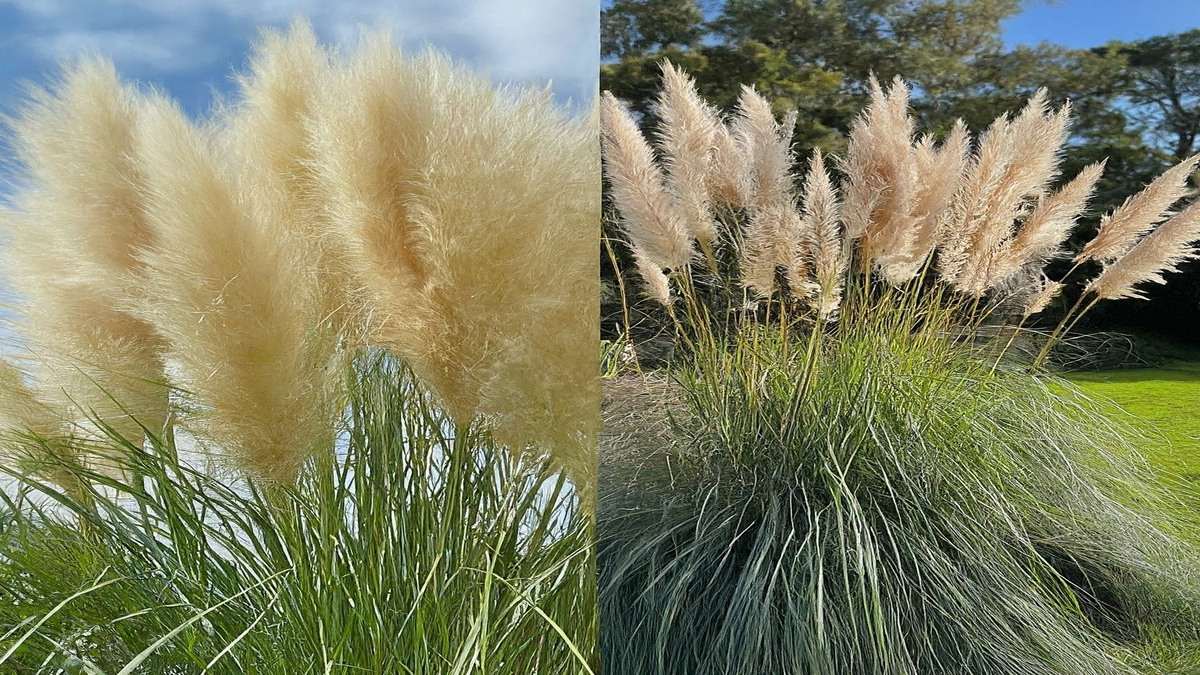What kills pampas grass? Various methods can be used to effectively kill pampas grass, each with its own advantages and considerations. These methods range from manual removal and herbicidal control to more drastic measures such as burning. The choice of method often depends on the size of the infestation, the specific characteristics of the area, and the resources available. In the following sections, we will explore these methods in detail, providing practical tips and precautions to ensure effective and safe removal of pampas grass.
Natural Methods
Natural methods for killing pampas grass are eco-friendly and can be quite effective. They typically involve manual removal or the use of natural herbicides.
Manual Removal
Manual removal is a hands-on approach that involves cutting down the grass and digging up its root system. Here’s a step-by-step guide:
- Safety First: Begin by wearing protective clothing, including long-sleeved shirts, pants, gloves, and eye protection. Pampas grass has extremely sharp leaf edges that can cause cuts.
- Preparation: Wrap your pampas grass in duct tape. This will make it easier to clean up after you cut it down.
- Trimming: Trim the plumes of the grass as close to the ground as possible to prevent seed dispersal.
- Removal: Carefully remove the foliage layer by layer, revealing the central clump of roots.
- Digging: Use a shovel or a spade to dig around the base of the clump, loosening the soil.
- Uprooting: Firmly grip the clump and lift it from the ground, ensuring you remove as much of the root system as possible.
- Disposal: Dispose of the plant material properly, as Pampas Grass can regenerate from fragments.
Natural Herbicides
Natural herbicides can also be used to kill pampas grass. One such herbicide is vinegar, which acts as acetic acid and can burn the leaves of the plant, causing it to wither away over time. Here’s how to apply it:
- Preparation: Trim or tie back the sharp leaves of the plant so you can access the base of the plant.
- Application: Apply the vinegar directly to the root ball.
- Waiting Period: Wait for up to two weeks for the entire system to completely die.
- Reapplication: If necessary, reapply the vinegar.
Remember, it’s important to apply vinegar during dry weather conditions to avoid inadvertently harming nearby plants, as vinegar has a non-selective nature. Always follow all safety guidelines when using natural herbicides.
Chemical Herbicides
Chemical herbicides are substances used to control undesired plants, such as pampas grass. They work by inhibiting cell division, photosynthesis, or amino acid production, or by mimicking natural plant growth hormones, causing deformities. They can also act by damaging leaf cells and causing them to dry up, altering the uptake of nutrients, interfering with growth and development, or interfering with photosynthesis.
Recommended Herbicides for Pampas Grass
The most recommended herbicides for killing pampas grass are glyphosate and haloxyfop. Glyphosate is a broad-spectrum systemic herbicide that kills weeds by inhibiting a plant enzyme involved in the synthesis of three key amino acids. Haloxyfop is a selective herbicide that is effective against grassy weeds.
Application Instructions and Safety Precautions
When applying chemical herbicides, it’s important to follow these steps for safety and effectiveness:
- Read the Label: Always read the herbicide label for specific instructions on use, storage, and disposal.
- Wear Protective Clothing: Use gloves, goggles, and long-sleeved shirts to protect your skin and eyes.
- Prepare the Plant: Trim or tie back the sharp leaves of the pampas grass so you can access the base of the plant.
- Apply the Herbicide: Apply the herbicide directly to the root ball. If you have a large area of pampas grass, a backpack sprayer may make application easier.
- Wait: It may take up to two weeks for the entire system to completely die. If necessary, reapply the herbicide.
- Clean Up: Rinse spray equipment and flush hoses and nozzles. Wash yourself, clothing, and protective equipment.
- Store Safely: Store herbicides in original containers in a locked cabinet away from temperature extremes and away from children and pets.
Remember, it’s important to follow all directions on herbicide labels, as these chemicals can be lethal if used improperly. Always be cautious when applying pesticides.
Mechanical Removal
Mechanical removal of pampas grass involves physically eliminating the plant from its location. This method is often used for smaller infestations or in areas where the use of chemicals may not be desirable.
Techniques for Mechanical Removal:
- Trimming: Start by cutting the grass as close to the ground as possible. This can be done using pruning shears, a saw, or even electric hedge trimmers.
- Digging: After trimming, use a shovel or a spade to dig around the base of the plant, loosening the soil. The aim is to remove as much of the root system as possible, as pampas grass can regenerate from fragments.
- Uprooting: Once the soil is loose, grip the plant firmly and lift it from the ground.
Tools and Equipment Needed:
- Protective Clothing: Pampas grass has sharp leaf edges that can cause cuts, so it’s important to wear long-sleeved shirts, pants, gloves, and eye protection.
- Pruning Shears or Loppers: These are essential for cutting through the thick and fibrous stems of the plant.
- Shovel or Spade: A sturdy shovel or spade will aid in digging out the roots from the soil, especially the deep-seated ones.
- Wheelbarrow or Bucket: These are useful for disposing of the roots.
Advantages and Disadvantages:
- Advantages: Mechanical removal is environmentally friendly as it doesn’t rely on chemicals. It can be effective if done correctly, especially for smaller infestations.
- Disadvantages: This method can be labor-intensive and time-consuming, especially for larger infestations. Also, pampas grass has a massive root system, and any remaining roots can lead to regrowth. Therefore, diligence and thoroughness are crucial for successful eradication.
Preventing Regrowth
Preventing the regrowth of pampas grass involves a combination of diligent monitoring, effective strategies, and long-term maintenance plans.
Strategies to Prevent Pampas Grass from Growing Back:
- Seed Bank Management: Pampas grass produces a large number of seeds that can remain viable in the soil for extended periods. Regularly removing any new shoots can help manage the seed bank.
- Rhizome Removal and Monitoring: Thoroughly excavating and removing pampas grass rhizomes, which can persist in the soil and give rise to new shoots, is vital for preventing regrowth.
- Use of Root Barriers: Consider using a root barrier to prevent the spread of pampas grass roots.
Tips for Maintaining a Pampas Grass-Free Area:
- Regular Monitoring: Regularly monitor your landscape for any signs of pampas grass.
- Alternative Landscaping Options: Explore alternative landscaping options to maintain a thriving and pampas grass-free landscape.
- Proper Disposal: Dispose of any pampas grass clippings or plants in a sealed bag or container to prevent reestablishment.
Long-Term Maintenance Plans:
- Regular Pruning: Regular pruning helps maintain the beauty of your landscape and prevents overgrowth.
- Yearly Cutting Back: Cut the pampas grass down as close to the ground as possible, then cover it with several inches of mulch or cardboard. This will block out sunlight and prevent the pampas grass from growing.
- Stay Vigilant: After removing pampas grass, keeping an eye out for new growth and managing the soil can stop it from returning.
- Bringing Back Native Plants: Bringing back native plants can also help protect the landscape.
Remember, the key to preventing the regrowth of pampas grass is persistence and regular maintenance. It may take some time, but with consistent effort, you can maintain a pampas grass-free area.
Environmental Considerations
Impact of Different Removal Methods on the Environment:
- Physical Removal: This method is environmentally friendly as it doesn’t rely on chemicals. However, it can be labor-intensive and time-consuming, especially for larger infestations.
- Chemical Removal: Chemical methods, such as herbicides, can be effective in killing pampas grass, especially when used in combination with physical removal methods. However, they can also have negative impacts on the environment if not used properly. Herbicides can leach into the soil and waterways, affecting non-target plants and wildlife.
Best Practices for Minimizing Environmental Harm:
- Proper Disposal: Dispose of any pampas grass clippings or plants in a sealed bag or container to prevent reestablishment.
- Use of Protective Clothing: Pampas grass has sharp leaf edges that can cause cuts, so it’s important to wear long-sleeved shirts, pants, gloves, and eye protection.
- Mindful Use of Herbicides: If you choose to use herbicides, it’s important to follow all directions on the labels, as these chemicals can be harmful if used improperly.
Alternatives to Consider for Eco-conscious Gardeners:
- Native Grasses: Native grasses such as Switchgrass (Panicum virgatum), Indiangrass (Sorghastrum nutans), and Little Bluestem (Schizochyrium scoparium) are great alternatives to pampas grass.
- Other Ornamental Grasses: Feather reed grass, blue oat grass, maiden grass, Japanese forest grass, Pink Muhly grass, Ravenna grass, fiber optic grass, and silver grass are also good alternatives.
- Eco-friendly Grass Alternatives: Clover, no-mow grasses, herbs, meadows, rock gardens, and more are eco-friendly alternatives that can turn your lawn green.
Remember, the key to minimizing environmental harm is to be mindful of the methods used for removal and to consider eco-friendly alternatives when possible. It’s also important to dispose of pampas grass properly to prevent its spread.
Safety Precautions
Important Safety Measures When Handling Herbicides and Machinery:
- Proper Use: Always follow instructions for mixing and use exactly. Be concerned with cleanup and disposal at all times during the use process.
- Ventilation: All herbicides must be handled in well-ventilated areas to minimize inhalation of toxic vapors.
- Equipment Maintenance: Keep your equipment clean, calibrated, and working properly.
- Avoid Unauthorized Access: Keep children and unauthorized people away from where pesticides are being mixed, loaded, applied, or stored.
Protective Gear Recommendations:
- Protective Clothing: Wear long-sleeved shirts, long pants, or coveralls.
- Chemical-Resistant Gloves: Always wear unlined gloves and never wear cotton, leather, or canvas gloves when applying pesticides.
- Safety Eyewear: It’s recommended to wear safety eyewear as an extra precaution.
- Chemical-Resistant Boots: These can provide additional protection.
Safe Disposal of Removed Pampas Grass:
- Secure Disposal: Dispose of the pampas grass roots by bagging them up and putting them in the garbage bin for collection.
- Composting: If the grass has already dried out, you can consider composting it or using it as mulch.
- Landfill Disposal: Always remove and securely bag flower heads before any involved maintenance to prevent inadvertent spreading of seeds. Landfill disposal is recommended.
Remember, safety is paramount when dealing with herbicides and machinery. Always follow the manufacturer’s instructions and take necessary precautions to ensure your safety. It’s also important to dispose of pampas grass properly to prevent its spread.
Where does pampas grass grow best?
Conclusion
In conclusion, managing pampas grass effectively is a task that requires a strategic approach. Whether you choose mechanical removal, chemical control, or professional burning, the key is to select the method that best suits your situation and preferences. Remember, early action can make the process easier and more manageable. So, don’t delay – start today and win back your garden from the grip of pampas grass!
FAQs
Here are some Frequently Asked Questions (FAQs):
- What is the most effective method to kill pampas grass? The most effective method to kill pampas grass depends on the size of the infestation and your personal preferences. For small infestations, mechanical removal might be feasible. For larger infestations, chemical control using herbicides like glyphosate might be more practical.
- Can chemical herbicides effectively kill pampas grass? Yes, chemical herbicides like glyphosate and imazapyr can effectively kill pampas grass. Glyphosate is better to use around herbicide-sensitive plants you want to keep. However, it’s important to follow the manufacturer’s instructions to minimize harm to other plants and the environment.
- Is mechanical removal a viable option for killing pampas grass? Yes, mechanical removal is a viable option for killing pampas grass, especially for smaller infestations. This involves physically removing the grass by digging it out. It’s labor-intensive but can be effective.
- How does controlled burning help in killing pampas grass? Controlled burning is another method used to manage pampas grass. This should only be done by professionals and where it is legal and safe to do so. It’s important to clear the area around the grass so that nothing else will catch on fire.


